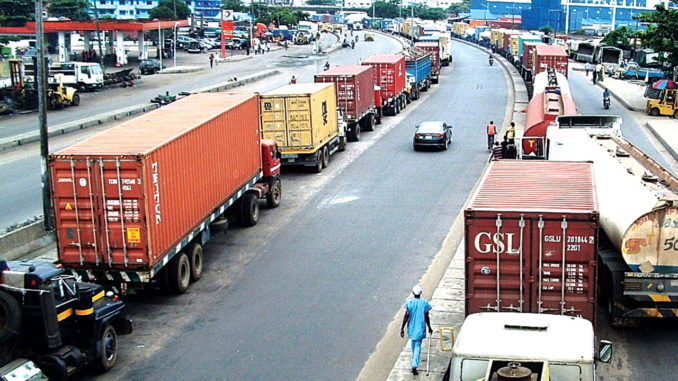
I have been an ardent listener of your review programme on Classic FM since 2014. And although I do not agree with everything you say, I can vouch for your sincerity and balanced judgement. I have also admired your tenacity and drive for a better and more liveable environment.
I listened to your comments on the menace of trucks on Lagos roads and will like to make a few points as regards what the issues really are. I work in the downstream oil and gas sector, I’ve been involved in the logistics business and I live in Festac Town, perhaps the most agonized community as regards the topic of discussion.
First, I will like to dispel some misconceptions as regards the trucks. One is that it is a relatively recent issue. It is not. It has only recently go into the headlines because the Ikorodu Road/Eko Bridge axis has been affected. The Apapa- Oshodi expressway has been like this for a very long time. Another misconception is that the trucks were moved to a conducive place during the president’s visit. They were not. They were just moved out of sight of most Lagosians. Yes, some of them moved to parks along the Ibadan expressway, both most clogged the inner streets along Babs Animashaun, Orile and Mile 2 axis.
Now to the crux of the matter. Yes you are correct in saying the trucks are doing business on the roads, that the security agencies are making a killing out of this challenge, that perhaps Govt officials are getting a cut, and that the money making ventures will not stop any time soon. However, that’s not the root of the matter. The money making venture and the business center this menace has become, are just unscrupulous agents of Govt making a killing out of a bad situation. They didn’t create it, and neither did the truck drivers.
Nigeria is an import dependent country, and most of our imports come in through the Apapa/Tin Can corridor. That is a lot of traffic coming in through one port, especially when the port’s infrastructure was designed for maybe 10% of the current traffic. Add to that the fact that most of the available spaces at the ports have been concessioned (read: sold) to flour and cement manufacturers and fuel depots, and you’ll begin to understand the origins of the problem. You also need to understand the exceptionally slow operations at our ports. The time it takes to clear a container at the Cotonou port is 11 times less than the time it takes in Lagos. I have not even begun to talk about the non-existent roads leading to the ports.
According to some estimates, for our import dependent lives to function the way it does, approximately 2,000 – 4,000 goods carrying vehicles must enter and leave the various terminals of the ports every day. These include container laden trucks, fuel tankers, flatbeds, lorries, flour and cement vehicles, etc. It doesn’t matter what method you use, these volume of articulated vehicles will cause traffic, because the roads are bad and the port operations are inefficient and non-effective. Many people have proposed the ‘drive only at night’ solution. Can you imagine 4,000 trucks rushing from wherever to the ports every night? And since they can rush in, load and leave in a single night, the logistics nightmare will definitely spill into the morning rush hour. Same issue applies with the ‘call from the park’ scenario. There is a solution, and the Govt know it, but we will get into that later.
It is this logjam that makes all the money making allegations, possible. You see, because of the time it takes to get into and out of the ports, all the trucks are now jostling for prime positions as close to the port as possible. And since the traffic arrangement is at the discretion of the Naval/Army/Police personnel, that prime position is now for sale. And since the importer/clearing agent/fuel dealer wants his business done as quickly as possible, he tends to only hire trucks as close to the port entrance as possible. Even trucks returning empty containers to the port terminals, have to bribe their way through, because your balance is paid only after you return the container. You mentioned the trucks of a certain conglomerate and that you can’t understand how their arrangement works. I’m sure you noticed that ALL their trucks are neatly arranged in a line every single time. It’s because instructions to ensure that their passage is as smooth as logistically possible, comes from an oga at the top. Your guess is as good as mine, what transpires between the said conglomerate, and oga himself.
Now to solutions. Although the Lagos port cargo throughput is nowhere near Busan, Shanghai or Singapore, It is way too much for the infrastructure available. Getting in and out of the port is a nightmare because of roads with potholes as big as 40ft containers. And off course the port operations are too cumbersome, with all the agencies of Govt jostling to get a foothold in the clearing and forwarding business. These are the major problems. The solutions are:
* Ensure other ports are working. You can designate certain goods to certain ports, give incentives like lower duties to goods imported through other ports.
* Invest massively in port infrastructure. These include roads, rail, terminals, etc. The depot manager in my organisation has not driven to the office in 6 years.
* Streamline the operations at our ports. Too many agencies operating at the port. The number of stamps required to clear a container is amazing. Digitize the operations.
If fewer trucks are required to come to Lagos, and those trucks have easy entry and exit from the ports, and they spend less time in the port, this traffic menace will end.
Thank you for coming to my TED talk. Keep up the good work.
END

Be the first to comment